|
Oct
14
2024
|
|
Posted 1 years 95 days ago ago by Admin
|
|
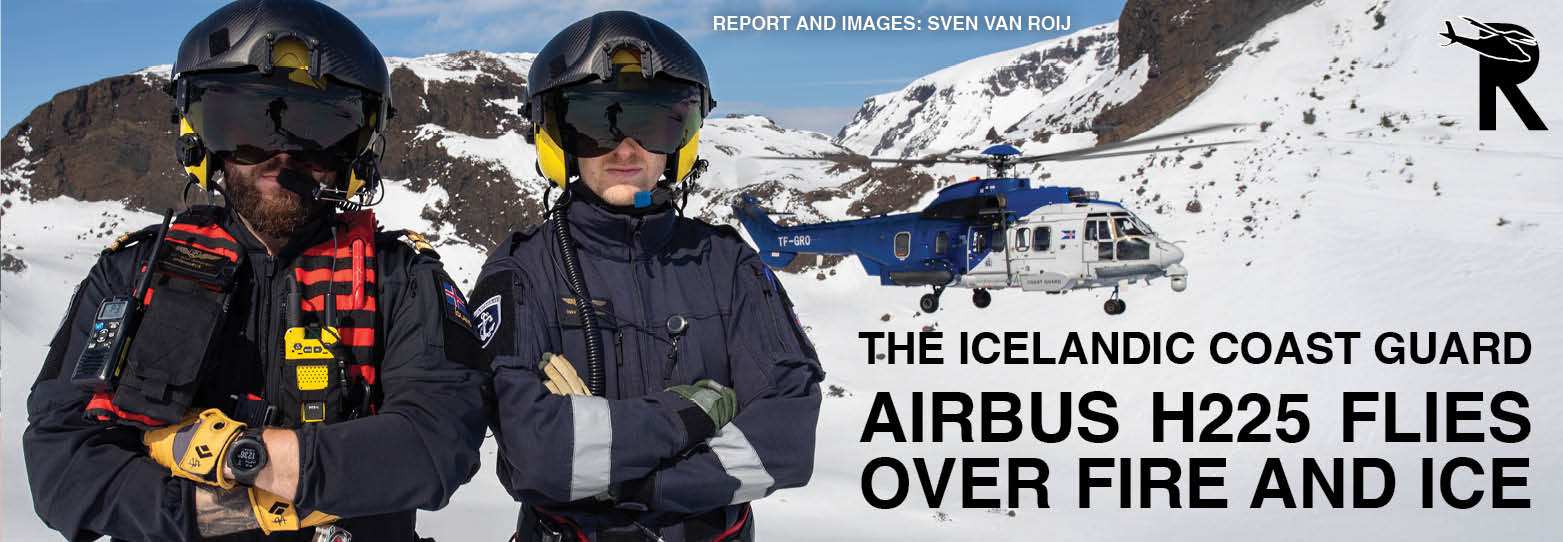
The Icelandic Coast Guard has three Airbus Helicopters H225s at its disposal. Their operating area ranges from countless waterfalls to dangerously cold seawater and from snow-white glaciers to newly formed land rising from the earth's core. Director General Georg Kristinn Lárusson describes five years of flying the H225 in a challenging and dynamic environment with constantly changing weather and a wide range of tasks.
Iceland is located between the North Atlantic and Arctic Ocean and is known for its unparalleled natural beauty. Three tectonic plates, including the North American and Eurasian, provide much volcanic activity and attract many visitors throughout the year. The island is home to under 400,000 residents, but that number increases fivefold each year due to visiting tourists. Reykjavík Domestic Airport houses the fleet of the Icelandic Coast Guard (ICG) that consists of three Airbus H225s and one fixed-wing Dash 8 Q300 maritime surveillance aircraft.
Georg Kristinn Lárusson, ICG director general for nearly two decades, said, “Last year, the ICG completed a record number of 314 helicopter missions, with the busiest period being when tourists visit in June, July, and August. The majority of these missions are for medical evacuations (MEDEVAC) and search and rescue (SAR) operations on land, while 30% are conducted at sea. We are fully equipped and prepared to handle the high demand during the summer months.”
New kids in town
In the early days of helicopter operations with the Icelandic Coast Guard, six helicopters were written off or damaged due to accidents. Over the years, accident rates decreased due to fleet modernization. “Our first helicopters, such as the Bell 47J and Sikorsky S-62, were older in design and suffered from lack of power. With the introduction of more capable helicopters, safety and capability increased. The Eurocopter SA365N Dauphin was our first multi-engine helicopter suitable for both visual flight rules (VFR) and instrument flight rules (IFR). The Aérospatiale AS332L1 Super Puma was also equipped with a 4-axis autopilot, fully capable of a de- and anti-icing system and dual hoist. Later, the Super Puma became the type on which we first flew with night vision goggles (NVGs),” Lárusson said.
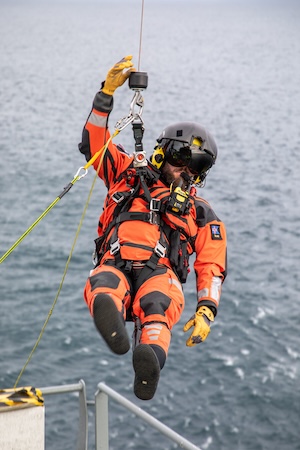
Flight safety, capability and safety took an even bigger leap with the arrival of the first Airbus Helicopter H225 in April 2019. The three H225s, which feature automatic flight control systems (AFCS), replaced the three AS332L1 Super Pumas. The H225s are leased via Norwegian lessor Knut Axel Ugland Holding AS. The fleet is equipped with a TrakkaBeam A800 searchlight, a WESCAM MX-15 multi-sensor, multi-spectral imaging system and a double hoist. The third and final H225 was delivered to the ICG in May 2021. The Icelandic Coast Guard named the three aircraft after the Norse gods Gná, Gróa and Eir.
Unaffected by vexing weather
Lárusson said, “We are capable of conducting SAR, and MEDEVAC missions within the Icelandic exclusive economic zone (EEZ). The Icelandic SAR region covers a vast area of approx. 1.2 million square miles, while the EEZ is approx. 437,500 square miles. Our helicopters are specifically outfitted for rescue operations and feature external fuel tanks as standard to increase range. Additionally, we provide support to police or civil protection services, and we can deploy the helicopters equipped with Bambi Buckets in the event of wildfires.”
The island is vast and has deep gorges and high mountains. Environmental factors combined with Iceland’s subpolar oceanic climate regularly create varied types of weather within a day. Winter conditions can make maintenance in the cold difficult and lubricating oils take on a thicker composition. According to the director general, this is rarely a limiting factor: “Our helicopters are designed for this specific weather and operational conditions. The manufacturer specifies which lubricants should be used when operating in cold weather. Cold temperatures can be tough on the engines, but this can be minimized by storing the aircraft in warm hangars and having access to ground power units. In addition, crews on duty monitor the weather prior to their mission. The H225 is also a true all-weather SAR helicopter. Our crews can continue their mission in virtually all types of weather, even during severe icing conditions because the type is fully de-icing certified. Deployment restrictions are start-up wind limits of 55 knots or freezing drizzle/rain.”
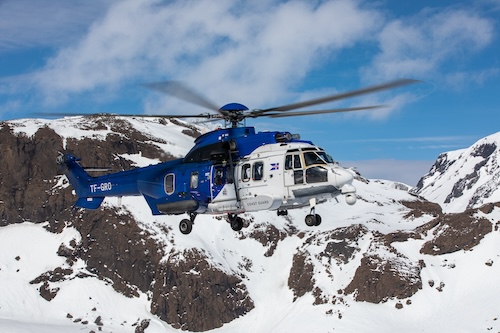
Above fire and ice
Besides being able to operate in a diversity of weather, the ICG has been regularly deployed during volcanic eruptions in recent months. “Our crews have been deployed to monitor the area along with scientists from the Icelandic Meteorological Office (IMO) and the civil protection service before and after the eruption. The crews have conducted hoist missions with electrical cables over the new lava and are also prepared to carry out evacuations in the event of an eruption,” Lárusson clarifies. “With these flights, crews provide a record of information to the government. With the information about crevasse size, thermal image and lava flow direction, an effective plan of action can be implemented on the ground.”
Each H225 is equipped with two powerful Turbomeca Makila 2A1 turboshaft engines. According to Lárusson, no modifications have been made to the engine, intake or exhaust to operate near lava flows, volcanic eruptions or ash clouds. The flights are conducted safely, without impacting the engine or other components. Captain Jens Sigurdarson, an ICG pilot, adds, “Flying has not been a problem for us during the recent eruptions, where we have had flowing lava streams in particular. Relatively few ash particles are released from that. During the explosive volcanic eruptions under the glacier Eyjafjallajökull in 2010, huge amounts of ash were released. That shut down air traffic for over a week. At first, we were not allowed to fly then either. Shortly thereafter, zones were designated in which we were or were not allowed to fly, depending on the shape and direction of movement of the ash cloud.”
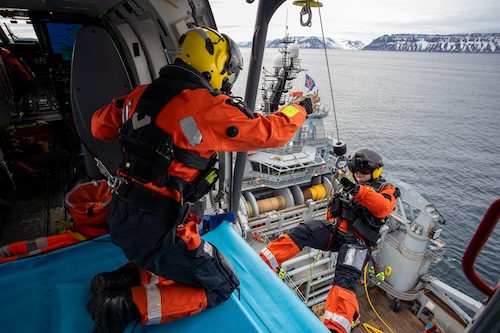
Small fleet availability
The combination of diverse tasks, a small fleet, the annual influx of visitors and not having a forward base brings challenges. It takes over a flight-hour to reach the north side of the island from the base at Reykjavík Domestic Airport. The ICG has found a practical solution to this. Captain Sigurdarson said, “If we head out for an injured person further away, the Dash 8 Q300 flies to an airfield closest to the injured person. We provide the rescue, fly to the airfield, and the fixed-wing then flies the casualty back to the hospital in Reykjavík as soon as possible. This solution not only ensures that the victim receives medical help faster, but after refueling at the airport, we are also ready for a new assignment.”
Lárusson attributes the failure to disperse crews and aircraft across different locations on the island to a lack of funding. “Multiple forward stations is an expensive operation for a country with only 380,000 people. With the current setup, we have the whole operation in the same place and most of the population lives in and around the capital area,” he explains. “The H225’s main gearbox also has a low-time precautionary scheduled maintenance schedule. The main gearbox maintenance schedule is not a limiting factor, but rather a lack of available technical manpower, lack of onsite spare parts, and longer delivering time of spare parts are limiting. Other operators in our area have stated they need a fleet of five or six helicopters to have two available constantly, The ICG scheduled maintenance program schedules one H225 for maintenance at a time, keeping two operational. For safety reasons, a second H225 must stand as a backup if a helicopter deployment is beyond 20 nautical miles. In doing so, we achieve an availability rate where 98-99% of the year we have one H225 available and 60% of the year we have two H225s at our disposal. With six crews – each consisting of a commander, co-pilot, rescue man with EMT-A, hoist operator with EMT-B and sometimes a flight physician from the state hospital – our goal is to have two crews and two helicopters readily available 24/7.” In this way, the ICG flew 314 rescue missions last year. In the first half of this year, 96 rescue missions were flown.
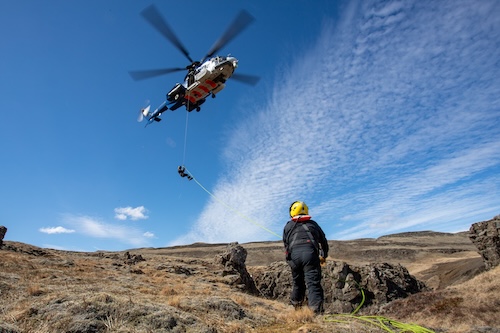
On the job
The ICG crews work on one-week shifts, which amounts to 168 hours. Lárusson said, “They are on standby from home and must live within a 15 km (9.4 mile) radius from the airport. It’s a 7-day on, 7-day off system. Each week, a flight plan is created to outline all scheduled flights, including training, law enforcement or other missions. Crews must be prepared to respond to scrambles as they occur, which may require the cancellation or rescheduling of previously scheduled flights. Technicians work daytime and overtime when needed. Our aim is always to have all of them licensed and certified for both line and base maintenance on our helicopter fleet.”
Despite labor market shortages, all positions within the Icelandic unit have been filled. The ICGs’ annual budget allows for six helicopter crews, which gives around 75% availability of two crews year-round. The director general indicates he needs seven crews to increase crew availability to over 95%. The ICG has a very low turnaround of personnel. Lárusson considers this extraordinary, saying, “This is likely the most desirable job for helicopter pilots here in Iceland. However, each helicopter pilot accumulates around 200 flight hours per year, which is very low. It takes co-pilots many years to advance to commander.”
The ICG and NATO
Iceland has been a member of the North Atlantic Treaty Organization (NATO) since its foundation in 1949. The ICG is responsible for day-to-day execution of security and defense related tasks in Iceland, as well as the implementation of host-nation support for Allied and NATO forces in Iceland. Therefore, the ICG is also responsible for the Keflavík Airbase (AB).
Although there are options to arm the H225 with the Airbus platform-interchangeable and onboard weapon system ‘HForce,’ the ICG's helicopters remain unarmed. To help keep Icelandic airspace safe and secure, NATO frequently conducts Icelandic air policing missions from Keflavík AB. These missions are flown three times a year by allies, with one rotation lasting three to four weeks. The ICG is responsible for providing SAR capabilities with its helicopters when the air policing is conducted in Iceland.
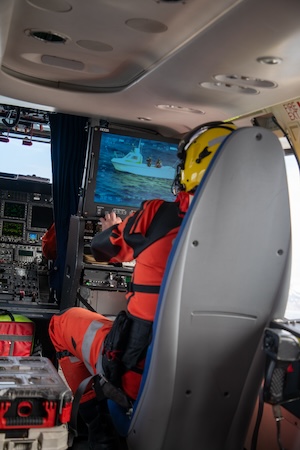
Future
The Icelandic Coast Guard, established in 1926, has significantly evolved over the past 98 years. Lárusson concludes, “Our responsibilities now encompass a wide range of tasks, including combating illegal activities such as illegal migration and drug trafficking, enforcing fisheries regulations, monitoring and responding to pollution incidents, protecting natural resources and the environment, as well as conducting salvage and rescue operations. The ICG is now well-prepared to respond swiftly to crisis situations, including rescuing individuals in distress at sea or on land, providing urgent medical transport, and assisting vessels within the country's jurisdiction. The future of the Icelandic Coast Guard is bright. We have never been as well-equipped, and our crews and personnel are world-class. It has been an honor to witness the flourishing of the Coast Guard over the last two decades.”
READ MORE ROTOR PRO: https://justhelicopters.com/Magazine
WATCH ROTOR PRO YOUTUBE CHANNEL: https://buff.ly/3Md0T3y
You can also find us on
Instagram - https://www.instagram.com/rotorpro1
Facebook - https://www.facebook.com/rotorpro1
Twitter - https://twitter.com/justhelicopters
LinkedIn - https://www.linkedin.com/company/rotorpro1